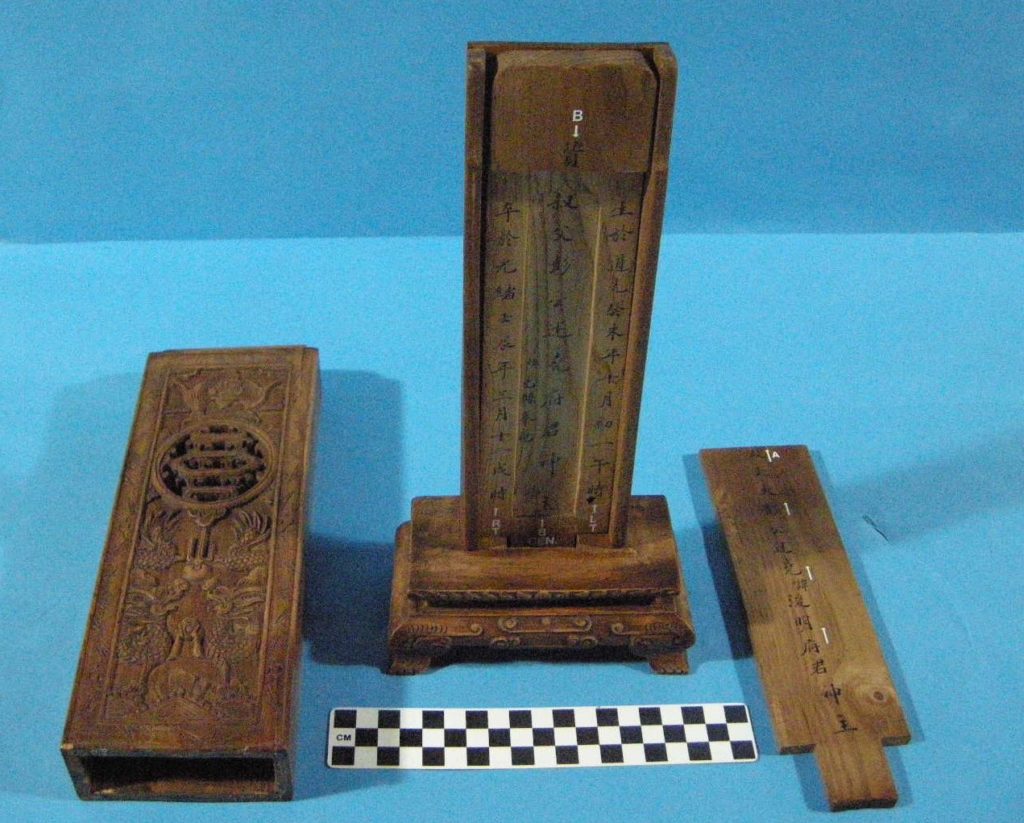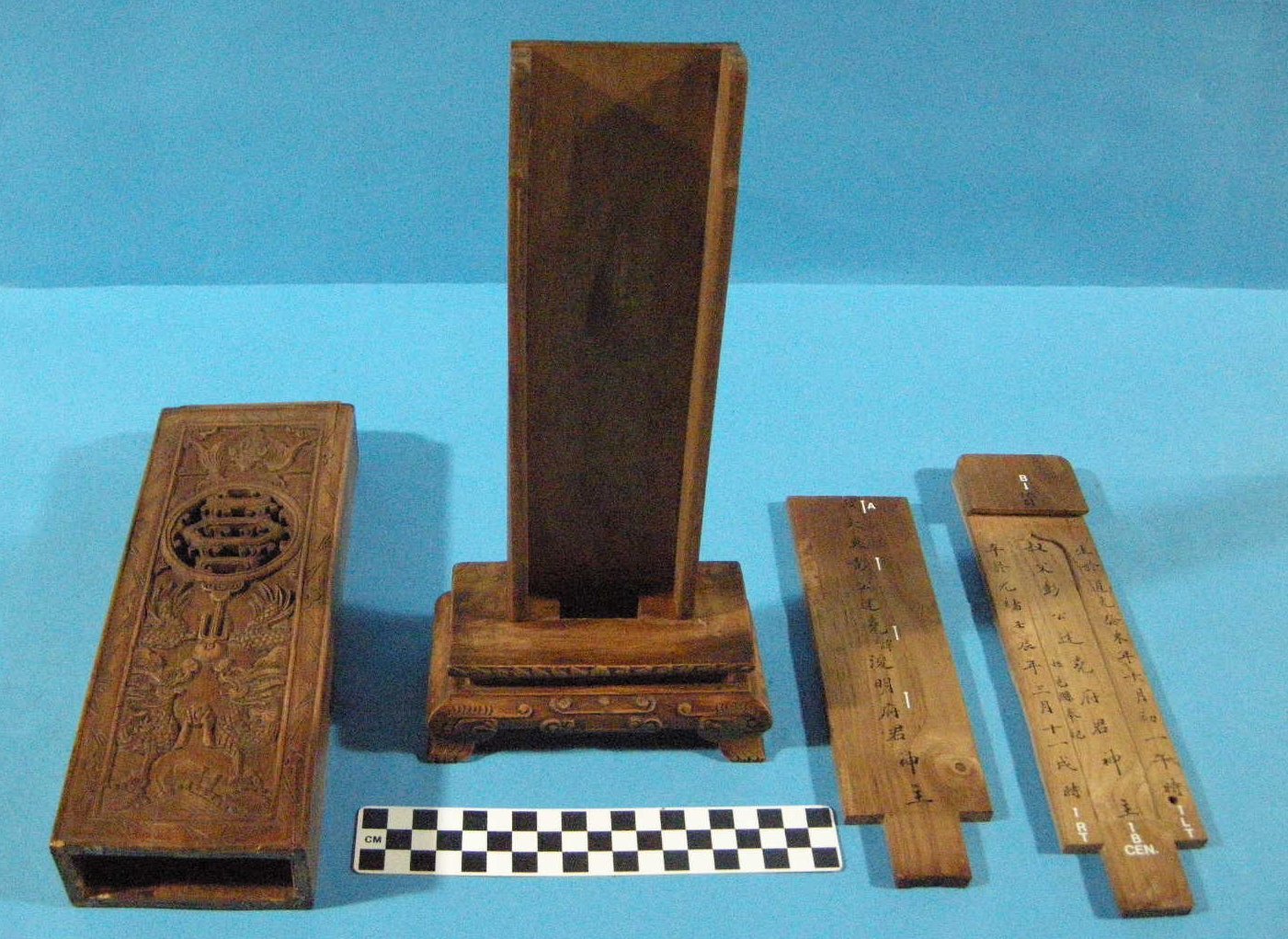日志
苏格兰国家博物馆里的中国祖先牌位
热度 8 |
Ancestral tablet - Description:Ancestral tablet of cedar wood, with gilt lettering (name, title and dates of deceased plus burial place and name of son) and ornament: China, Qing Dynasty, 19th century。Museum reference:A.L.209.1。
Ancestral tablet - Description:Ancestral tablet of polished brown wood, consisting of two slabs inscribed with Chinese characters in black ink, together fitting into the base: China。Museum reference:A.1953.3。To the Chinese, ancestral tablets are a home for the spirit of a deceased person after burial. They are kept in a shrine in the house and the living worship and make offerings to the spirit. This one was made for a man who lived 1796-1882. The wooden tablet comprises a base, a backboard and a front board. The ink inscription records details of the deceased and the names of his male descendants who installed the tablet. A red dot on the front board 'fixed' the spirit inside the tablet. The ancestors are very important in Chinese belief, and keeping them happy is important for the well-being of the living. Offerings are made at ancestor tablets on the anniversaries of the birth and death of the individual.
这样的中国祖宗牌位,在田纳西大学博物馆里,也有一个,解释的也更加详细:Ancestral tablet of wood, consisting of two slabs inscribed with Chinese characters in black ink, together fitting into a base, in commemoration of a widow: China。Museum reference:A.1919.668。
中国人的祖先牌位,原先是供奉在堂屋和家庙里的,逢年过节,初一十五,都烧香磕头,顶礼膜拜。五四以后,不过百年,尤其是文革一起,这些个祖先牌位,都和至圣先师孔老二一起被丢进了垃圾堆,而不是博物馆。取而代之的,是集一国之力,在南京建立了中山陵,在北京建立了纪念堂,结结实实的是只准朝廷放火不许百姓点灯的现代版。Chinese ancestral tablet, c. 1900, rosewood, gift of Becky Till, 1985.16.18. - Ancestor worship was and is a familiar practice in Chinese folk religion. One of the most common ways to venerate the dead is through the use of ancestral tablets like this one. The tablet displays an ink inscription of the predecessor’s name and accomplishments. The panel is then sheathed and supported by the wooden decorated box. This tablet then acts as an effigy for their spirit. Treated like an almost physical human, the panels are fed fruits, tea, and pastries. Worshiping descendants will light incense sticks before approaching their ancestors. Incense is believed to aid in the transfer of prayers and communication with spirits. The average traditional Chinese home will have its ancestral tablet and/or shrine in the living room area.
全部作者的其他最新日志
- • 西方爱情诗选 之 我思故我爱
- • 从文自传 之 湘西儒将
- • 千年世家 之 神仙打架
- • 从文自传 之 杀人
- • 灯下漫笔 之 河南匪气
- • 租界里的杂文 之 募捐
发表评论 评论 (2 个评论)
- 回复 水风
- 其实也不是都进了垃圾箱或者被当了烧火的劈柴。我家的祖先牌位,【其实就是我高祖一个人的】就藏在家里的壁龛后面。前面又挡了一块木板,外面刷了层石灰。看起来跟普通的壁龛没啥两样。不过我们也不再供养。只是每年清明鬼节时候,两柱香而已。后来家里房屋修缮,我爷爷亲自动手把神主拆出来。就是块旧木板,烟熏的黑黑的。现在应该在大伯家,但从来没看到过。估计也没有供养过。
- 回复 水风
- 最后一句话是在发牢骚么?中山陵是国民党建的,而且很早就修好了。这个要怪土共好像怪错了人。毛的纪念堂,如果毛活过来,会被再次气死一次的。奋斗了一生想改造的东西,最终又放到了自己身上。
移风易俗,不是那么容易的。但数典忘祖也是不应该的。我一位政治老师说,苏联解体的主要原因就在于俄罗斯人骨子里就是虚无主义,虚无么,啥都不在乎了,肯定是无政府主义。都无政府了,那么有没有共产党自然也无所谓。所以,历次党内斗争,都挖坑鞭尸,啥黑暗部分都抖搂个精光。最后信仰没了,人心散了。
好在中国几千里历史下来。总算知道点为尊者讳。忌讳的,不是别的,而是社会生活里面伪善的道德良知。而这个也是维系一个社会所在的根本。










